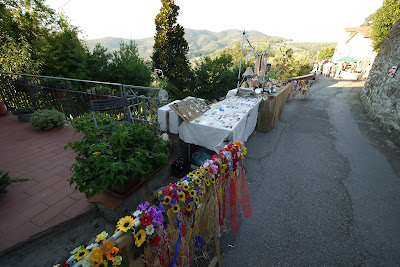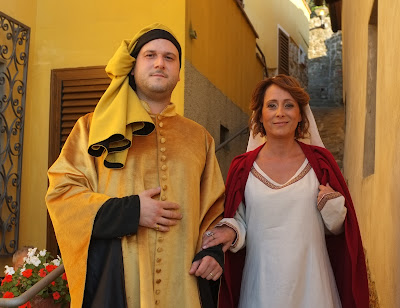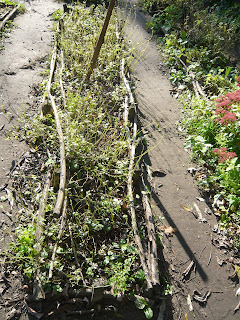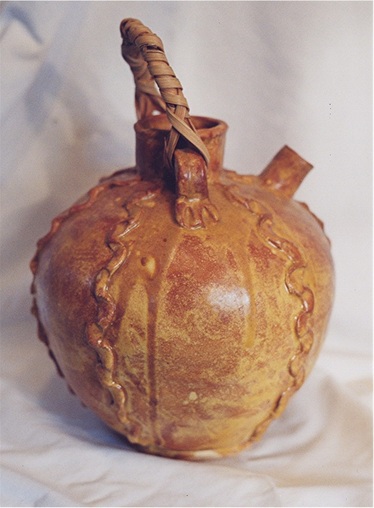The Bayeux Tapestry and various manuscripts provide the writer of historical fiction with an insight into early medieval costume. For example the lavish wealth of this world is evident in
Aelfric's Colloquy where a merchant sold purple silk and precious gems, coloured garments and dyes. Anglo-Saxon wills are another source of information as they reveal bequests of clothing.
 |
| Harold's Crowning at Westminster. The nobles were richly clad. |
Unusual Garments
Anglo-Saxon glosses often provide garment names that are fascinating. It is interesting to guess which are male, female or both or even what they are. Here are a few of my favourites:
A Gobweb- something made of precious cloth, frequently purple, usually silk, maybe shot silk or taffeta.
But what is a Gobweb? No one knows but if you have a suggestion perhaps you would share your knowledge.
Breast-lin - a linen band for the breast, perhaps a garment, maybe something else, or could it be a wrap for a corpse?
A Breast-rocc- a garment covering the chest. Is it linen underwear?
Smoc- a shirt, undergarment, possibly embellished.
Slop- an upper garment that is loose and made of linen.
Under-sec - undershirt
Nihtwarn- nightwear worn by men, but what about women?
In cupboards, clothing chests and coffers one might discover an array of swiftlere -low slippers, feax-net-hairnets, gloves, mittens, belts, girdles, clasps, ornaments, amulets.
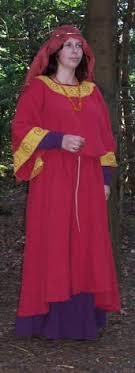 |
| Contrasting bands of gold material and the circlet gold fillet |
My Lady's Gown
At night a lady might hang her long-sleeved gown on a clothing pole. She would set aside her headdress, one designed to conceal the neckline. Circa 1066 her gown was tailored but she also had a sleeveless overgown which hung loose from her shoulders. Wide sleeves were in fashion and these flared into exaggerated points. The overgown was often brightly coloured and ankle length with a pronounced hem and sometimes this possessed a contrasting border. In a picture supposed to represent Judith of Flanders her tight belt is visible at the front of the gown to cinche the fabric and show off the waist.
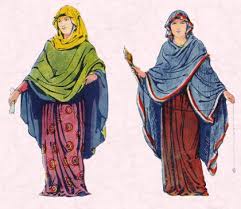 |
| Patterned fabric and hooded or veiled headdresses |
My Lady's Undergarments
Sleeves belonging to an underdress visible at the wrist were of linen material. Occasionally the fabric was drawn together with needle and thread, soaked and stretched thus creating pleats. They were not permanent and could wash out!
Stripes of cloth wound around the legs from mid calf to the ankle can be seen in early medieval pictures of women on horseback.
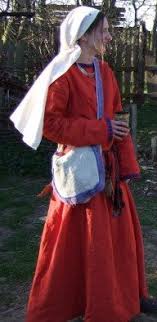 |
| A simpler dress and loose headdress but also hair showing on the forehead |
My Lady's Headdresses
It is thought that young girls wore their hair long and loose over their shoulders but a band might keep it neat. Women covered their heads indoors and out. Head bands were worn with a cloth headdress to conceal both neck and shoulders.
The Fillet, often mentioned in
The Handfasted Wife, was considered a characteristic feature of the married woman's appearance. It was worn in conjunction with a headdress of fabric. Streamers ending in decorated tags emerge from the veil or hood at the back. The Fillet was a narrow piece of fabric embroidered, brocaded, possibly jewelled or it could be a circlet of silver worn outside a hood. It is thought that in the late eleventh century women wore their hair up. A plait or firm mound of hair was practical since it was all the easier for pinning a wimple, veil or hood onto it.
 |
| Bands for the head |
My Lady's Shoe Collection
Elditha, the heroine of
The Handfasted Wife, placed her shoes up on the rafters. She had ankle shoes that were flat-soled. They were plain with a strip running down the front of the foot. The toes have modest points. She had several pairs of low shoes or slippers and at least one pair of fine deerskin boots.
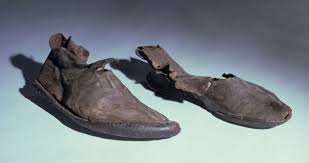 |
| And shoes of course |
Conquest
Anglo-Saxon textiles dazzled the Normans who often referred to them in writings. Their fabrics included imported silks often patterned, fabrics embroidered with gold, fabrics adorned with pearls and jewels and fur-trimmed robes. Matilda, the Conqueror's queen is known to have used English embroiderers. The world the Normans conquered was rich in art, literature, fabrics and jewels. Its noblemen and women were dressed extravagantly. So when Gytha, Harold's mother went into exile with a great treasure in 1068 she may well have carried with her many beautiful and valuable garments.


